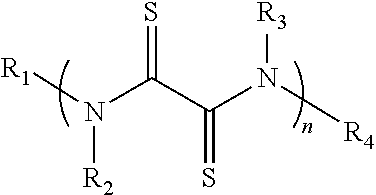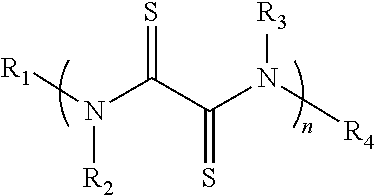Electrode active material, production method for said electrode active material, electrode and secondary battery
a production method and active material technology, applied in the direction of cell electrodes, electrical devices, cell components, etc., can solve the problems of battery instability, low capacity, and difficult to realize the multi-electron reaction which can be expected of a high capacity, etc., to achieve stable charge-discharge reaction, excellent cycle characteristics, and high reactivity
- Summary
- Abstract
- Description
- Claims
- Application Information
AI Technical Summary
Benefits of technology
Problems solved by technology
Method used
Image
Examples
example 1
Preparation of Secondary Battery
[0106]A rubeanic acid indicated by the chemical formula (1a) was prepared.
[0107]
[0108]Then, 100 mg of the rubeanic acid and 0.2 mg of oxamide were mixed to prepare a mixture for an active material (the content of the oxamide: 0.2% by mass).
[0109]Subsequently, 800 mg of graphite powder as a conductive aid, and 200 mg of polytetrafluoroethylene as a binder were respectively weighed, and these weighed materials and the above-mentioned mixture (100.2 mg) for an active material were kneaded while being uniformly mixed, and thereafter the resulting mixture was pressure-formed to obtain a sheet-like member having a thickness of about 150 μm. Thereafter, the sheet-like member was dried at 70° C. for 1 hour in vacuum, and then punched out into a round shape with a diameter of 12 mm to prepare a positive electrode containing the mixture for an active material. Next, the positive electrode was impregnated with an electrolytic solution to allow the electrolytic s...
example 2
Preparation of Secondary Battery
[0115]The rubeanic acid used in Example 1 was heat-treated for 30 minutes in a thermostat bath at 80° C. to prepare a heat-treated product.
[0116]The heat-treated product was analyzed by a gas chromatograph mass spectrometer, and consequently it was found that 0.7% by mass of oxamide was contained in the heat-treated product.
[0117]Then, the resulting mixture of the rubeanic acid and the oxamide (rubeanic acid: 99.3% by mass, oxamide: 0.7% by mass) was used as a mixture for an active material, and a hermetically sealed coin battery was prepared in the same manner as in Example 1.
[0118]Check of Operation of Secondary Battery
[0119]The coin battery thus prepared was charged at a constant current of 0.1 mA until a voltage reached 4.2 V, and thereafter, was discharged at a constant current of 0.1 mA until a voltage reached 1.5 V. Consequently, the battery was verified to be a secondary battery having a discharge capacity of 0.32 mAh, which had a plateau at a...
example 3
Preparation of Secondary Battery
[0122]A coin battery was prepared in the same manner as in Example 1 except for using, as the electrolytic solution, which used an ionic liquid including 1-ethyl-3-methylimidazolium bis(trifluorosulfonyl)imide as an electrolyte and contains LiN(CF3SO2)2 (electrolyte salt) having a mole concentration of 1M, in place of the mixed solution of methyltetraglyme and LiN(CF3SO2)2.
[0123]Check of Operation of Secondary Battery
[0124]The above-mentioned coin battery was charged at a constant current of 0.1 mA until a voltage reached 4.2 V, and thereafter, was discharged at a constant current of 0.1 mA until a voltage reached 1.5 V. Consequently, the battery was verified to be a secondary battery having a discharge capacity of 0.46 mAh, which had a plateau at a charge-discharge voltage of 2.1 V.
[0125]A capacity density per mass of the active material, calculated from the discharge capacity, was 620 Ah / kg, and this compound was verified to be an electrode active m...
PUM
| Property | Measurement | Unit |
|---|---|---|
| oxidation-reduction voltages | aaaaa | aaaaa |
| oxidation-reduction voltages | aaaaa | aaaaa |
| temperature | aaaaa | aaaaa |
Abstract
Description
Claims
Application Information
 Login to View More
Login to View More - R&D
- Intellectual Property
- Life Sciences
- Materials
- Tech Scout
- Unparalleled Data Quality
- Higher Quality Content
- 60% Fewer Hallucinations
Browse by: Latest US Patents, China's latest patents, Technical Efficacy Thesaurus, Application Domain, Technology Topic, Popular Technical Reports.
© 2025 PatSnap. All rights reserved.Legal|Privacy policy|Modern Slavery Act Transparency Statement|Sitemap|About US| Contact US: help@patsnap.com



